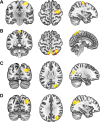Neural Dedifferentiation across the Lifespan in the Motor and Somatosensory Systems
- PMID: 32043110
- PMCID: PMC7232989
- DOI: 10.1093/cercor/bhz336
Neural Dedifferentiation across the Lifespan in the Motor and Somatosensory Systems
Abstract
Age-related declines in sensorimotor performance have been linked to dedifferentiation of neural representations (i.e., more widespread activity during task performance in older versus younger adults). However, it remains unclear whether changes in neural representations across the adult lifespan are related between the motor and somatosensory systems, and whether alterations in these representations are associated with age declines in motor and somatosensory performance. To investigate these issues, we collected functional magnetic resonance imaging and behavioral data while participants aged 19-76 years performed a visuomotor tapping task or received vibrotactile stimulation. Despite one finding indicative of compensatory mechanisms with older age, we generally observed that 1) older age was associated with greater activity and stronger positive connectivity within sensorimotor and LOC regions during both visuomotor and vibrotactile tasks; 2) increased activation and stronger positive connectivity were associated with worse performance; and 3) age differences in connectivity in the motor system correlated with those in the somatosensory system. Notwithstanding the difficulty of disentangling the relationships between age, brain, and behavioral measures, these results provide novel evidence for neural dedifferentiation across the adult lifespan in both motor and somatosensory systems and suggest that dedifferentiation in these two systems is related.
Keywords: aging; connectivity; dedifferentiation; sensorimotor; task activity.
© The Author(s) 2020. Published by Oxford University Press. All rights reserved. For permissions, please e-mail: journals.permissions@oup.com.
Figures







References
-
- Astafiev SV, Stanley CM, Shulman GL, Corbetta M. 2004. Extrastriate body area in human occipital cortex responds to the performance of motor actions. Nat Neurosci. 7:542–548. - PubMed
-
- Brodoehl S, Klingner C, Stieglitz K, Witte OW. 2013. Age-related changes in the somatosensory processing of tactile stimulation-an fMRI study. Behav Brain Res. 238:259–264. - PubMed
Publication types
MeSH terms
Grants and funding
LinkOut - more resources
Full Text Sources
Medical

